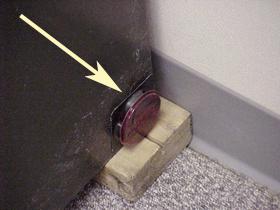Introduction
A bait is a mixture of a toxic chemical (an insecticide) mixed with some food item (such as sugar) that attracts an insect pest. For pests such as ants and cockroaches, the baits only attract the insects when they come into contact with the bait while foraging (looking for food). Insect baits are available in many different forms, from granules that are used mostly outdoors (such as the fire ant bait shown in Figure 1) to gels and soft solid materials that are commonly used in offices, kitchens and other areas where ants are active. You can find information about commonly used insect baits in the North Carolina Agricultural Chemicals Manual.
For an ant bait to be truly effective requires several steps. You want the worker ants to:
- Find the bait
- Carry small quantities of the bait back to their nest where they feed it to the queen(s), brood (Figure 2) and other workers.
- Recruit other workers in the nest to go collect the bait.
Baits have some advantages over other types of insecticides. First, baits can work when the nest cannot be found or it is inaccessible for treating with other chemicals. Second, they pose less of a risk to children and pets by reducing possible contact with any toxic chemical. Third, baits can kill the entire colony whereas most insecticides sprayed on a surface kill only the workers that contact it and some sprays may actually be repellent (which doesn't kill the ants but may only "detour" them to another food source temporarily). A disadvantage of baits is that the workers must find it and so you need to have some idea of where ant activity is consistently occurring.
What is critical to remember is that baits are effective only if they are eaten by the ants and not all baits are equally attractive to different ant species. You may need to get help from your local N.C. Cooperative Extension center to identify the ants in question. Make sure that the bait you use is acceptable to the ants. Place a small amount of bait where you see ants foraging (walking back and forth) and then watch how they respond to the bait for a few minutes. If the ants show no interest in the bait, try a different bait until you find one that they will will readily eat. Once you find a bait that is acceptable to the ants, there are several other important details to controlling the ants with the bait:
- Proper placement - Bait should be placed in known or suspected areas of ant activity, such as near a cabinet or piece of equipment (Figure 3). Be sure to place the bait out of the reach of children, pets, and wildlife. Never place bait directly on countertops where food is prepared or an area where it will get wet and contaminated or where it may accidentally contaminate water in a sink, pet drinking bowl or a drain.
- Amount of bait - Make sure you provide enough bait and check it daily to make sure that it isn't depleted. If the ants carry away all of the bait before you return, then they may leave that area and go somewhere else before enough bait is spread within the colony. Large ant colonies may require multiple locations and amounts the bait. Leave the bait in place for 3-4 days after you see no more signs of feeding by the ants.
- Sanitation - Baits work best when there are no other food items accessible to the ants. Keep these areas clean so the ants are not “distracted” from finding and feeding on the bait.
- Durability - baits eventually age and become unacceptable particularly if they are exposed to high temperatures, rain and sunlight. Check baited areas for signs of ant feeding and replace baits that are no longer acceptable to the ants.
Patience is important to successful baiting. Most ant baits are slow-acting and do not kill the ants quickly. Therefore, you may continue to see ants for a week or more after baiting. However, successful baiting requires that the ants are able to return to the nest with the bait so it can be fed to other colony members (particularly the queen). Do not disturb or kill the ants with insect sprays or other means. Spraying the ants (or the area baited) will contaminate the bait and likely repel the ants away from the area. If you are baiting indoors and do not wish to see ants, try placing the bait in less obvious areas (but where you see some ant activity) such as under/behind appliances, sinks, etc.
For additional information on ant control, consult A Guide to House-Invading Ants and Their Control.
Publication date: May 1, 2018
Reviewed/Revised: May 11, 2023
The use of brand names in this publication does not imply endorsement by NC State University or N.C. A&T State University of the products or services named nor discrimination against similar products or services not mentioned.
N.C. Cooperative Extension prohibits discrimination and harassment regardless of age, color, disability, family and marital status, gender identity, national origin, political beliefs, race, religion, sex (including pregnancy), sexual orientation and veteran status.



